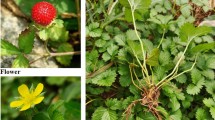Abstract
Objectives
The aim was to evaluate the activity of seven medicinal, anti-inflammatory plants at the hH4R with focus on defined chemical compounds from Curcuma longa.
Materials
Activities were analyzed with membrane preparations from Sf9 cells, transiently expressing the hH4R, Gαi2 and Gβ1γ2 subunits.
Methods
From the methanolic extract of C. longa curcumin (1), demethoxycurcumin (2) and bis(4-hydroxy-cinnamoyl)methane (3) were isolated, purified with HPLC (elution-time 10.20, 9.66, 9.20 min, respectively) and together with six additional extracts, were characterized via radioligand binding studies at the hH4R.
Results
Compounds from C. longa were the most potent ligands at the hH4R. They exhibited estimated K i values of 4.26–6.26 µM (1.57–2.31 µg/mL) (1); 6.66––8.97 µM (2.26–3.04 µg/mL) (2) and 10.24–14.57 µM (3.16–4.49 µg/mL) (3) (95% CI). The estimated K i value of the crude extract of curcuma was 0.50–0.81 µg/mL. Fractionated curcumin and the crude extract surpassed the effect of pure curcumin with a K i value of 5.54 µM or 2.04 µg/mL [95% CI (4.47–6.86 µM), (1.65–2.53 µg/mL)].
Conclusion
Within this study, defined compounds of C. longa were recognized as potential ligands and reasonable lead structures at the hH4R. The mode of anti-inflammatory action of curcumin was further elucidated and the role of extracts in traditional phytomedicine was strengthened.



Similar content being viewed by others
References
Dunford PJ, O’Donnell N, Riley JP, Williams KN, Karlsson L, Thurmond RL. The histamine H4 receptor mediates allergic airway inflammation by regulating the activation of CD4+ T cells. J Immunol. 2006;176:7062–70.
Zaid H, Raiyn J, Osman M, Falah M, Srouji S, Rayan A. In silico modeling techniques for predicting the tertiary structure of human H4 receptor. Front Biosci. 2015;21:597–619.
Cragg GM, Newman DJ. Medicinals for the millennia. The historical record. Ann N Y Acad Sci. 2001;8:2–25.
Lee K-H. Discovery and development of natural product-derived chemotherapeutic agents based on a medicinal chemistry approach. J Nat Prod. 2010;73:500–16.
Lahlou M. The success of natural products in drug discovery. Pharmacol Pharm. 2013;4:17–31.
Harvey A. The role of natural products in drug discovery and development in the new millennium. IDrugs. 2010;13:70–2.
Aggarwal BB, Harikumar KB. Potential therapeutic effects of curcumin, the anti-inflammatory agent, against neurodegenerative, cardiovascular, pulmonary, metabolic, autoimmune and neoplastic diseases. Int J Biochem Cell Biol. 2009;41:40–59.
Mousavi SZ, Bathaie SZ. Historical uses of saffron: identifying potential new avenues for modern research. AJP. 2011;1:57–66.
Bhat SP, Rizvi W, Kumar A. Effect of Cuminum cyminum L. seed extracts on pain and inflammation. J Neurosci Res. 2014;14:186–92.
Ocana-Fuentes A, Arranz-Gutierrez E, Senorans FJ, Reglero G. Supercritical fluid extraction of oregano (Origanum vulgare) essentials oils: anti-inflammatory properties based on cytokine response on THP-1 macrophages. Food Chem Toxicol. 2010;48:1568–75.
Ali-Shtayeh MS, Jamous RM, Salameh NMY, Jamous RM, Hamadeh AMA. Complementary and alternative medicine use among cancer patients in Palestine with special reference to safety-related concerns. J Ethnopharmacol. 2016;187:104–22.
Ammon HPT, Wahl MA. Pharmacology of Curcuma longa. Planta Med. 1991;57:1–7.
Mahdizadeh S, Ghadiri MK, Gorji A. Avicenna’s canon of medicine: a review of analgesics and anti-inflammatory substances. AJP. 2015;5:182–202.
Jurenka JS. Anti-inflammatory properties of curcumin, a major constituent of Curcuma longa. Altern Med Rev. 2009;14:141–53.
Shehzad A, Lee YS. Molecular mechanisms of curcumin action: signal transduction. Biofactors. 2013;39:27–36.
Schneider EH, Seifert R. Sf9 cells: a versatile model system to investigate the pharmacological properties of G protein-coupled receptors. Pharmacol Ther. 2010;128:387–418.
Kottke T, Sander K, Weizel L, Schneider EH, Seifert R, Stark H. Receptor-specific functional efficacies of alkyl imidazoles as dual histamine H3/H4 receptor ligands. Eur J Pharmacol. 2011;654:200–8.
Yung-Chi C, Prusoff WH. Relationship between the inhibition constant (K i ) and the concentration of inhibitor which causes 50 per cent inhibition (IC50) of an enzymatic reaction. Biochem Pharmacol. 1973;22:3099–108.
Raz O, Rogowski O, Rosenzweig T, Shapira I, Berliner S, Boaz M. Anti inflammatory effect of high complex carbohydrate diet in obese volunteers: gender related effects. Atherosclerosis. 2015. doi:10.1016/j.atherosclerosis.2015.04.942.
Williamson EM. Synergy and other interactions in phytomedicines. Phytomedicine. 2001;8:401–9.
Stark H. Histamine H4 receptor: a novel drug target for immunoregulation and inflammation. London: Versita; 2013.
Cheng A-L, Hsu C-H, Lin J-K, Hsu M-M, Ho Y-F, Shen T-S, et al. Phase I clinical trial of curcumin, a chemopreventive agent, in patients with high-risk or pre-malignant lesions. Anticancer Res. 2001;21:2895–900.
Shoba G, Joy D, Joseph T, Majeed M, Rajendran R, Srinivas PS. Influence of piperine on the pharmacokinetics of curcumin in animals and human volunteers. Planta Med. 1998;64:353–6.
Sasaki H, Sunagawa Y, Takahashi K, Imaizumi A, Fukuda H, Hashimoto T, et al. Innovative preparation of curcumin for improved oral bioavailability. Biol Pharm Bull. 2011;34:660–5.
Tsai Y-M, Chang-Liao W-L, Chien C-F, Lin L-C, Tsai T-H. Effects of polymer molecular weight on relative oral bioavailability of curcumin. Int J Nanomed. 2012;7:2957–66.
Cho E, Jung S. Supramolecular complexation of carbohydrates for the bioavailability enhancement of poorly soluble drugs. Molecules. 2015;20:19620–46.
Nelson KM, Dahlin JL, Bisson J, Graham J, Pauli GF, Walters MA, et al. The essential medicinal chemistry of curcumin: miniperspective. J Med Chem. 2017;60:1620–37.
Pappalardo M, Shachaf N, Basile L, Milardi D, Zeidan M, Raiyn J, et al. Sequential application of ligand and structure based modeling approaches to index chemicals for their hH4R antagonism. PLoS One. 2014. doi:10.1371/journal.pone.0109340.
Wagner H, Ulrich-Merzenich G. Synergy research: approaching a new generation of phytopharmaceuticals. Phytomedicine. 2009;16:97–110.
Acknowledgements
This study was supported by the Al-Qasemi Research Foundation, the Ministry of Science, Space and Technology, BM0806, CM1204 and CA15125 COST Actions as well as DFG INST 208/664 and GRK2158. We declare that the funders had no role in study design, data collection and analysis, decision to publish, or preparation of the manuscript.
Author information
Authors and Affiliations
Corresponding author
Additional information
Responsible Editor: Bernhard Gibbs.
Rights and permissions
About this article
Cite this article
Frank, A., Abu-Lafi, S., Adawi, A. et al. From medicinal plant extracts to defined chemical compounds targeting the histamine H4 receptor: Curcuma longa in the treatment of inflammation. Inflamm. Res. 66, 923–929 (2017). https://doi.org/10.1007/s00011-017-1075-x
Received:
Revised:
Accepted:
Published:
Issue Date:
DOI: https://doi.org/10.1007/s00011-017-1075-x




